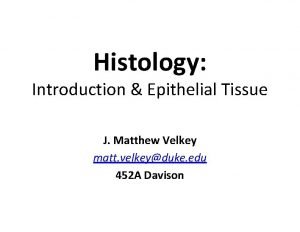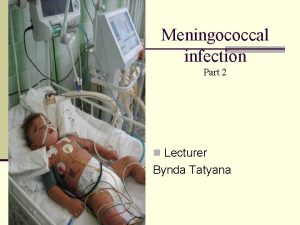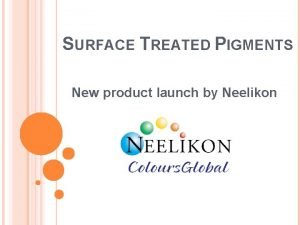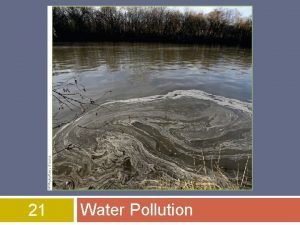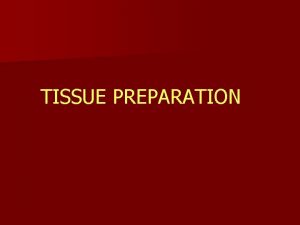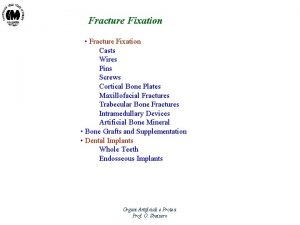TISSUE PREPARATION Tissue fixation Tissue is treated with



















- Slides: 19

TISSUE PREPARATION

Tissue fixation: Tissue is treated with fixatives. 4% Formaldehyde or physical fixative as heat or microwave. These fixatives causes crosslinking of macromolecules so that biological Activity is arrested. Tissue embedding Fixed tissues are cut in small slices. for this we have to embed them in Parrafin wax for light microscopy Resin for electron microscopy.

As tissues are hydrophilic and wax is hydrophobic what to do now Dehydrate tissues with ascending grades of alcohol 70 to 100% Dehydrating agent was relpaced by immersing in Xylene. These two processes are called dehydration and clearing. Now tissue ready for embedding. Tissues placed in metallic mould filled with paraffin wax at 58 -60 degree. Heat evaporates xylene and tissues get paraffinized. Tissue block placed in microtome for cutting. An instrument for slicing of tissues usaually 4 -5µm.

STAINING OF SLIDES: Usually H & E stains were used. They are water based stain and tissue is embedded in wax. Now what to do Put XYLENE and then rehydrate it. Descending grades of alcohol and then with distilled water Put hematoxyllin and decolorize it with acid alcohol quick dips and checked Microscopically. Acidic structures stain this basic dye. Rinse with tap water. Put eosin now Basic structures stain this acidic dye.

PRESERVE THE SLIDE: Dehydrate again with ascending grades of alcohol And cleared with xylene. Mount with coverslip.

Results: Nuclei Cytoplasm of pink Red blood cells Orange/red Blue/Black Varying shades

Artifacts in histology

n What one may see upon microscopic examination of sections of specimens of human and animal tissues is not always related to the normal histology or pathology of the tissue in question. n Defects or abnormalities in tissue sections are referred to as artifacts. n Structures or features in tissue that interfere with normal histological examination.

n Artifacts may occur at different stages in the routine collection of tissues, fixation, processing, cutting and staining of tissues. n Not always present in normal tissue and can come from outside sources. n Interfere with histology by changing the tissues appearance and hiding structures.

Pre-histology n Features and structures introduced prior to the collection of the tissues e. g. ink from tattoos.

Post-histology n Artifacts can result from tissue processing. Processing commonly leads to changes like shrinkage, color changes in different tissues types and alterations of the structures in the tissue. Because these are caused in a laboratory the majority of post histology artifacts can be avoided or removed after being discovered.

Formalin pigment

Tissue Fold

Tissue Tear

Retraction artifact

Unfixed tissues

Rough or Rapid Cutting

Failure To Stain Because Of Residual Wax On The Section

Floater/Carry over
 Internal and external fixation
Internal and external fixation Classification of fixatives used in histopathology
Classification of fixatives used in histopathology Steps in tissue processing
Steps in tissue processing Glandular epithelium
Glandular epithelium Mucosya
Mucosya Bp normal range
Bp normal range Market form for beef steak
Market form for beef steak Describe lee coker and amos hicks
Describe lee coker and amos hicks Soft bender rods
Soft bender rods Surface-treated pigments
Surface-treated pigments Treated vs untreated
Treated vs untreated Flixton sawmill price list
Flixton sawmill price list How were roman slaves treated
How were roman slaves treated Treat others the way you would like to be
Treat others the way you would like to be Homo sapiens the proud splitter
Homo sapiens the proud splitter Water treated from sewage treatment plant
Water treated from sewage treatment plant How can governments ensure citizens are treated fairly
How can governments ensure citizens are treated fairly Each packet is treated independently
Each packet is treated independently After shampooing chemically treated hair tends to
After shampooing chemically treated hair tends to Pressure treated fence panels
Pressure treated fence panels



